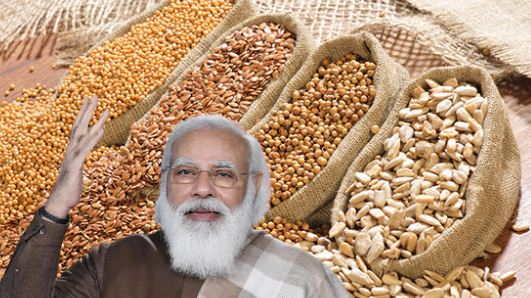The price of edible oil has been rising for some time, and it has become a major problem for the common people in the country. After the Green revolution, India became aatmanirbhar in staples such as wheat, rice but in the case of edible oil, we are still dependent on imports, and the issue comes back to haunt the common people and the government over and over again. Therefore, to find a permanent solution to the edible oil problem, the Modi government has announced National Mission on Edible Oil-Oil Palm (NMEO-OP), with a budgetary allocation of 11,000 crore rupees in the next five years.
The Prime Minister made this announcement during the virtual event in which 19,500 crore rupees were transferred to the accounts of 9.75 crore rupees under PM-KISAN.
Later, the PM also tweeted about the mission to make the country aatmanirbhar in edible oil. “The government will invest more than 11,000 crore via the National Mission on Oil seeds and Oil Palm to provide farmers everything possible, including better seeds and technology,” Modi said on Twitter.
“When India is emerging as a major exporter of farm goods, we should not depend on imports for our edible oil requirements,” he added.
In the last few years, especially after the pandemic, India’s agriculture export grew exponentially. India has become a major exporter of Rice, wheat, and pulses, and given the huge potential to grow edible oil at a large scale, edible oil should be the next target. As per the Ministry of Agriculture website, “The diverse agro-ecological conditions in the country are favourable for growing 9 annual oil seed crops, which include 7 edible oil seeds (groundnut, rapeseed & mustard, soybean, sunflower, sesame, safflower and niger) and two non-edible oil seeds (castor and linseed).”
Palm oil, which accounts for around 50-60 percent of India’s 13-15 million tonnes of annual oil imports, mainly comes from Malaysia and Indonesia. India’s annual consumption of edible oil is around 24 million tonnes and the domestic production is only 10 million tonnes. With the rise in disposable income, the consumption of oil is growing exponentially and is projected to touch 30 million tonnes by 2024-25.
So, every year, the country already imports 13-15 million tonnes of oil from countries like Malaysia, Indonesia, Brazil, and European countries. If the government does not takes steps to increase the area under the edible oil cultivation (0.5 million hectares), then import dependence is set to increase.
Palm oil can be easily grown in the Northeastern part of the country and islands. Yoga guru Baba Ramdev has already announced that his company, Patanjali, would be growing palm oil in Northeast India.
Under the new Mission, the Modi government aims to increase oil palm cultivation to 1 million hectares by 2025-26 and 1.7-1.8 million hectares by 2029-30 and bring down the import dependency to 20-30 percent.
The country shells out import bills of around 75,000 crore rupees every year on the import of edible oil, and given the fact oil is consumed in every household of the country, the volatility in oil prices hurt the household budgets.
Thus, the mission to make the country aatmanirbhar in edible oil was long due, and the Modi government’s decision to provide technological, monetary and policy support to edible oil farmers would ensure that in the next decade, India emerges as a major exporter of edible oil just like that of rice and wheat.
